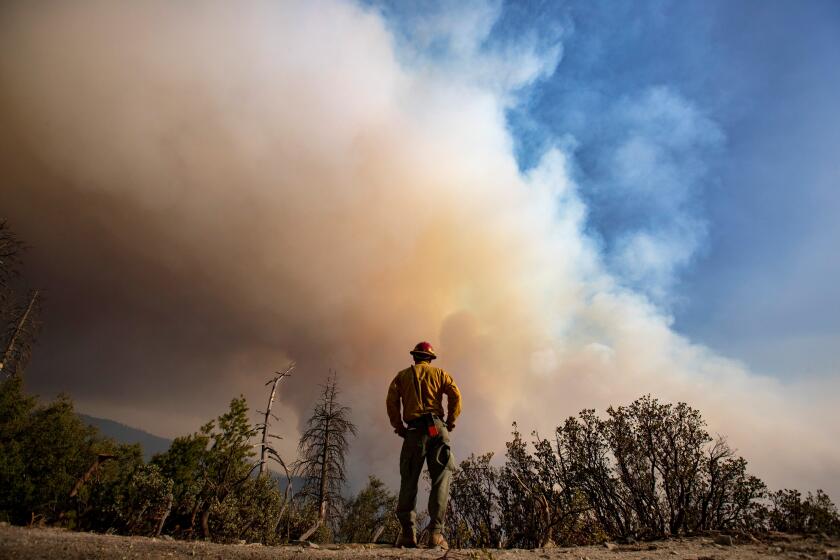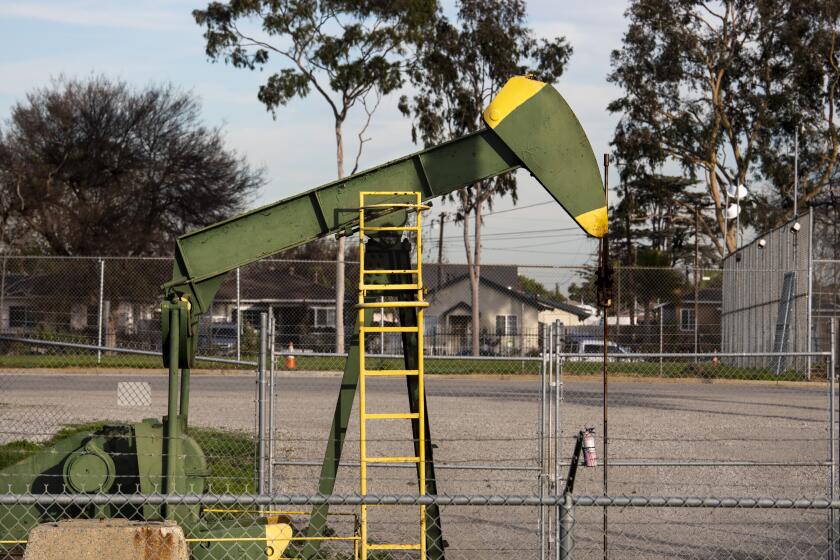We’re very far off course in meeting global climate goals. Get ready for Plan B

- Share via
When a modified Korean War-era aircraft bearing an unusual payload began crisscrossing the skies over Alaska in March, it opened a new frontier in the fight against climate change. During a dozen flights in a WB-57 bomber, 17 instruments customized for the mission spent 60 hours collecting trace gases in the Arctic stratosphere.
The goal is to acquire baseline observations of the stratosphere that would lay the groundwork for “climate intervention” should current efforts to stop burning fossil fuels fall short and global-warming-related catastrophes worsen.
Call it Plan B: a Hail Mary attempt to cool the atmosphere by injecting aerosols up to 12 miles above Earth’s surface to reflect sunlight back to space.
Some people say the best way to battle climate change is with optimism. Here’s why that won’t work.
Plan A, of course, is to slash our use of gas, oil and coal — the indisputable way to eventually slow and stop climate change. But in the wake of this year’s killer heat waves and other extreme-weather disasters, discussions about “geoengineering” are growing, although confined mostly to scientists and policymakers.
What’s lacking is sufficient public awareness of that debate, much less citizen engagement in it.
Driving the notion of climate intervention is the reality that, even if the world stopped spewing another molecule of carbon dioxide tomorrow, we’ve generated more than enough (1.8 trillion tons and counting) to guarantee that conditions will worsen.
Therein lies the allure of a techno fix to chill our planet. As the United Nations Environment Program framed it in February:
“Should the effects of climate change become broadly perceived to be unbearable, and the political pressure for governments to cool the Earth become intense,” some form of geoengineering “is the only known means available for governments that might feasibly cool the Earth on politically relevant time scales.”
The lexicon of delay uses “adaptation,” “resilience,” “geoengineering” and “carbon capture” to promise action, but they all fail to address the scale of the problem.
Plan B, though, comes with risks that are poorly understood — and untested. Chief among them is the potentially destabilizing effects of tinkering with the climate.
The cluster of geoengineering approaches now drawing the most attention is broadly called solar radiation modification.
“Solar aerosol injection” would deploy airplanes, balloons or rockets to spread droplets of sulfuric acid particles in the stratosphere. By reflecting more sunlight, they would provide a thin sunshade to lower atmospheric temperatures — perhaps in a year’s time, maybe less.
“Marine cloud brightening’’ calls for spraying sea salt aerosols into low clouds over the ocean to enhance condensation and brighten the clouds, causing them to also reflect more sunlight.
Global warming is ratcheting up the risk of extreme wildfire growth in California and will continue to do so for decades, even if emissions are reduced.
A third technique is “cirrus cloud thinning.” Instead of reflecting sunlight, tiny specks of ice nuclei would be launched into high-altitude cirrus clouds, forming ice crystals that allow infrared radiation (heat) to escape from the Earth. Scientists are also exploring ways to genetically modify food crops to make them more reflective — akin to painting rooftops white.
The best any of these techniques could do is buy us time to transition to clean, renewal sources of energy while reducing carbon dioxide emissions.
There is still so much unknown about the consequences of geoengineering that scientists in discussing this approach avoid using a “risks versus benefits” framework, but rather a “risk versus risk” proposition. What is known about solar radiation modification is its limitations.
None of the techniques addresses the intensifying acidification of our oceans — a major threat to coral reefs and marine life as sea temperatures have reached their highest ever. Reflecting sunlight also won’t appreciably reverse the loss of land ice or limit greenhouse gas emissions from fast-thawing permafrost.
A new study shows that fossil fuel investments dramatically underperformed for CalSTRS, CalPRS and individual retirees over the last 10 years.
But such shortcomings pale in comparison to the serious, even deadly, risks posed by geoengineering, which could cause uneven local and regional impacts around the world.
These include more acid rain. Greater air pollution. Increased malaria in developing countries. Heavier precipitation and devastating floods in northern Europe. More monsoon and drought in some parts of the world, less in others.
Solar radiation modification could renew the deterioration of our protective ozone layer. Diffusing sunlight could worsen soil acidity and lower the yield of corn, rice and soy — crops that prefer direct sunlight. Spraying droplets of sulfuric acid into the stratosphere also may cause the disappearance of blue skies.
Most scientists, unsurprisingly, are only calling for more research. Already, tens of millions of dollars are funding geoengineering research, limited largely to computer modeling work in laboratories.
The aerosol-gathering flights, such as those over Alaska, represent rare, actual fieldwork. That basic research project, led by the National Oceanic and Atmospheric Administration, will resume in 2025, focusing on the tropics and the Southern Hemisphere.
Looming over the entire debate is the absence of any political structure to set rules, with socioeconomic and equity guardrails.
Without international standards, might an aggrieved nation experiencing disproportionate climate change impacts or some rogue “Greenfinger” take unilateral action that could possibly trigger irreversible changes to our planet and even provoke armed conflict?
To address those concerns, an independent 16-member “Global Commission on Governing Risks from Climate Overshoot” was formed in 2022 to war-game the geopolitical and scientific ramifications if the world were to exceed — “overshoot” — its goal of limiting atmospheric warming to 1.5 degrees Celsius (2.7 degrees Fahrenheit) above preindustrial levels, a target widely embraced in Paris in 2015.
Aside from the debate over the pros and cons of geoengineering, the discussion has already given rise to two camps. One fears that any talk of climate intervention represents a step toward action. The other fears that the mere prospect of a quick fix would sap the will to slash CO2 emissions or, worse, increase fossil fuel use.
One who harbors such ambivalence is Frances Beinecke, a longtime climate activist and former president of the Natural Resources Defense Council. Nonetheless, she joined the overshoot commission, which plans to release its report this month.
“There’s no substitute for drastically reducing our carbon dioxide emissions and aggressively phasing out fossil fuels,’’ she told me. “But we also must prepare for the worst-case scenarios. That means conducting research on technologies and designing governance mechanisms to minimize and manage the increasing risks of a dangerous future.”
In 1965, President Johnson was advised that reflecting sunlight could cool Earth’s atmosphere. After decades of inaction and complacency about climate change, we now have little choice but to debate what seemed so outlandishly risky just a few short years ago.
Edwin Chen is a former Times reporter in Washington and is now writing a climate change novel.
More to Read
A cure for the common opinion
Get thought-provoking perspectives with our weekly newsletter.
You may occasionally receive promotional content from the Los Angeles Times.













